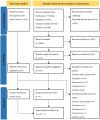Effectiveness of Interventions to Manage Difficulties with Breastfeeding for Mothers of Infants under Six Months with Growth Faltering: A Systematic Review Update
- PMID: 36839345
- PMCID: PMC9961185
- DOI: 10.3390/nu15040988
Effectiveness of Interventions to Manage Difficulties with Breastfeeding for Mothers of Infants under Six Months with Growth Faltering: A Systematic Review Update
Abstract
(1) Background: The current evidence on management of infants under six months (u6m) with growth faltering is limited and of low quality. This review aimed at updating an existing review to inform the WHO guideline update on prevention and management of growth faltering in infants u6m. The objective is to synthesise evidence on interventions to manage breastfeeding difficulties in mothers or caregivers of infants u6m with growth faltering to improve breastfeeding practices and breastmilk intake. (2) Methods: We searched PubMed, CINAHL, and Cochrane Library from December 2018 to December 2021 for experimental studies. Using RoB 2.0 and ROBINS-I tools, we assessed study quality and results were synthesised narratively. Using the GRADE approach, we assessed the quality of evidence for four outcome domains-breastfeeding (critical), anthropometric (important), mortality (important), and morbidity (important). (3) Results: We identified seven studies, conducted among neonates (mainly preterm, n = 14 to 607), and assessed the following interventions: (a) non-nutritive sucking (NNS) on breast (n = 2) and (b) alternative supplemental feeding techniques (n = 5, cup feeding, spoon feeding, supplemental feeding tube device, and syringe feeding), and reported breastfeeding and anthropometric outcomes. None of the studies reported mortality and morbidity outcomes. The reported breastfeeding outcomes included LATCH (Latch, Audible swallowing, Type of nipple, Comfort, Hold) total score, PIBBS (Preterm Infants Breastfeeding Behaviour Scale) total score, EBF (exclusive breastfeeding) at various time points and time to transition to full breastfeeding, and reported anthropometric outcomes included weight gain and weight at different time points. Studies had 'serious' indirectness and 'serious' to 'very serious' risks of bias. From the limited studies we found, NNS on breast compared to NNS on finger may have some benefits on PIBBS total score; NNS on breast compared to NNS on pacifier may have some benefits on EBF at discharge; and cup feeding compared to bottle feeding may have some benefits on EBF at discharge, at three months and at six months. (4) Conclusions: Evidence on the effectiveness of interventions to manage breastfeeding difficulties in mothers or caregivers of infants u6m with growth faltering to improve breastfeeding practices and increase breastmilk intake is 'limited' and of 'low' to 'very low' quality. As the majority of the infants in the included studies were neonates, no new recommendations can be made for infants from one to six months due to lack of evidence in this population. We need more studies targeting infants from one to six months of age. The review was registered with PROSPERO (CRD42022309001).
Keywords: breastfeeding; growth faltering; infant; malnutrition.
Conflict of interest statement
The authors declare no conflict of interest. The funders had no role in the design of the study; in the collection, analyses, or interpretation of data; in the writing of the manuscript; or in the decision to publish the results.
Similar articles
-
Cup feeding versus other forms of supplemental enteral feeding for newborn infants unable to fully breastfeed.Cochrane Database Syst Rev. 2016 Aug 31;2016(8):CD005092. doi: 10.1002/14651858.CD005092.pub3. Cochrane Database Syst Rev. 2016. PMID: 27577968 Free PMC article.
-
Early additional food and fluids for healthy breastfed full-term infants.Cochrane Database Syst Rev. 2016 Aug 30;2016(8):CD006462. doi: 10.1002/14651858.CD006462.pub4. Cochrane Database Syst Rev. 2016. PMID: 27574798 Free PMC article.
-
Breastfeeding or breast milk for procedural pain in neonates.Cochrane Database Syst Rev. 2023 Aug 29;8(8):CD004950. doi: 10.1002/14651858.CD004950.pub4. Cochrane Database Syst Rev. 2023. PMID: 37643989 Free PMC article.
-
Avoidance of bottles during the establishment of breastfeeds in preterm infants.Cochrane Database Syst Rev. 2021 Oct 21;10(10):CD005252. doi: 10.1002/14651858.CD005252.pub5. Cochrane Database Syst Rev. 2021. PMID: 34671969 Free PMC article.
-
Support for healthy breastfeeding mothers with healthy term babies.Cochrane Database Syst Rev. 2022 Oct 25;10(10):CD001141. doi: 10.1002/14651858.CD001141.pub6. Cochrane Database Syst Rev. 2022. PMID: 36282618 Free PMC article.
Cited by
-
"I can't provide what my child needs": Early feeding experiences of caregivers of children with craniofacial microsomia.J Pediatr Nurs. 2024 Jul-Aug;77:e366-e374. doi: 10.1016/j.pedn.2024.04.053. Epub 2024 May 10. J Pediatr Nurs. 2024. PMID: 38729894 Free PMC article.
-
Critical research gaps in treating growth faltering in infants under 6 months: A systematic review and meta-analysis.PLOS Glob Public Health. 2024 Jan 8;4(1):e0001860. doi: 10.1371/journal.pgph.0001860. eCollection 2024. PLOS Glob Public Health. 2024. PMID: 38190356 Free PMC article.
-
Factors associated with the anxiety score of deaf and hearing mothers.Codas. 2024 Aug 5;36(5):e20230239. doi: 10.1590/2317-1782/20242023239pt. eCollection 2024. Codas. 2024. PMID: 39109753 Free PMC article.
-
Prevention and Management of Growth Failure During the First 6 Months of Life: Recommendations by the Joint Committee of the Pediatric and Adolescent Nutrition Society and the IAP Infant and Young Child Feeding Chapter.Indian Pediatr. 2025 May;62(5):329-346. doi: 10.1007/s13312-025-00060-2. Epub 2025 Apr 11. Indian Pediatr. 2025. PMID: 40214941
-
Lactation physiokinetics-using advances in technology for a fresh perspective on human milk transfer.Front Pediatr. 2023 Oct 16;11:1264286. doi: 10.3389/fped.2023.1264286. eCollection 2023. Front Pediatr. 2023. PMID: 37908966 Free PMC article.
References
-
- Von Salmuth V., Brennan E., Kerac M., McGrath M., Frison S., Lelijveld N. Maternal-focused interventions to improve infant growth and nutritional status in low-middle income countries: A systematic review of reviews. PLoS ONE. 2021;16:e0256188. doi: 10.1371/journal.pone.0256188. - DOI - PMC - PubMed
-
- Blencowe H., Krasevec J., De Onis M., Black R.E., An X., Stevens G.A., Borghi E., Hayashi C., Estevez D., Cegolon L. National, regional, and worldwide estimates of low birthweight in 2015, with trends from 2000: A systematic analysis. Lancet Glob. Health. 2019;7:e849–e860. doi: 10.1016/S2214-109X(18)30565-5. - DOI - PMC - PubMed
Publication types
MeSH terms
Grants and funding
LinkOut - more resources
Full Text Sources
Medical
Research Materials


